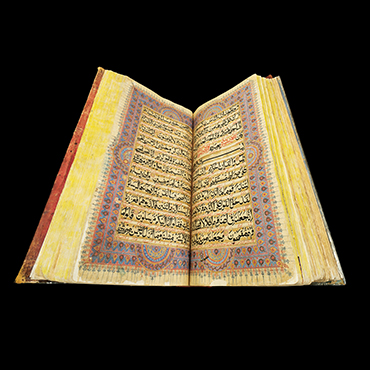Inscribing the Sacred
Copies of the Qur’an have long been produced in sizes ranging from the miniscule to the monumental. There are few, however, as grand in size as the copy shown in AlBidayah, which was produced in India as a gift to the Prophet’s Mosque in Al-Madinah al-Munawwarah. Requiring a special size of paper and originally bound in a bejeweled cover, it was a gift of considerable expense, yet its donor remains unknown. Further research will doubtless uncover the donor’s name and the circumstances under which this—one of the most remarkable examples of Islamic art in the world—was donated.
Outstandingly large, this Qur’an belongs to a tradition of objects donated by South Asian patrons to Makkah al-Mukarramah and Madinah. The grand staircase also shown in AlBidayah is another notable example.
Although the exact origins of this copy of the Qur’an are unknown, the chronicler Ayyub Sabri Pasha (d. AH 1308/1890 CE) states that it was sent from India to the Prophet’s Mosque and installed there in around AH 1250/1834–35 CE. It was placed on a specially crafted, locked Qur’an stand (kursi) near the Bab al-Salam entrance to the mosque. During the restoration of the Prophet’s Mosque, which began in AH 1273/1857 CE, the Qur’an was moved to storage in the mosque’s treasury. Its binding was later restored in AH 1302/1884–85 CE by Al-Hajj Yusuf bin al-Hajj Ma‘sum Namankani, a member of a community that included scholars and bibliophiles who had settled in Madinah from Namangan, Uzbekistan.
The text is penned in the naskh script in black ink, with Persian translations in red nasta‘liq script between the lines of the Qur’an. Although no longer attached, the original binding cover was gilded-leather, inset with rubies, emeralds, turquoise, and chrysolite.
The Qur’an is signed by the calligrapher Ghulam Muhyi al-Din. A calligrapher by this name, known for his piety and habit of distributing handwritten portions of the Qur’an to the poor, was based in Rampur, North India, and died in AH 1293/1876 CE. The decorative style of this Qur’an points to Northern India as its origin, possibly linking it to this very calligrapher.
Monumental Qur’an (35:45–36:15)
Northern India, possibly Rampur
Muharram 6, 1240 AH/August 31, 1824 CE, naskh and nasta‘liq scripts
Copied by Ghulam Muhyi al-Din
Endowed by an unknown ruler from India to the Prophet’s Mosque in Madinah, around AH 1250/1834–35 CE
Ink on paper, gold, opaque pigments, h. 139.7 × w. 77.5 cm
King Abdulaziz Waqf Libraries Assembly, Al-Madinah al-Munawwarah, Maktabat al-Mushaf al-Sharif, 223

